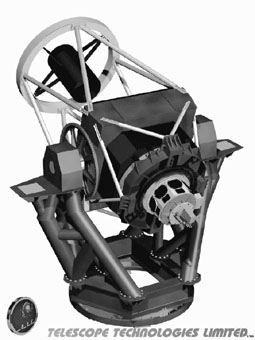 The Liverpool Telescope:
The Liverpool Telescope: A 2-metre robotic telescope facility available to UK amateurs
J. Brit. Astron. Assoc., 110, 2, 2000, p.61
 The Liverpool Telescope:
The Liverpool Telescope: Professor Mike Bode and colleagues at Liverpool John Moores University (JMU) and the National Museums and Galleries on Merseyside (NMGM), aided by support from PPARC, have been engaged for several years in a venture to reintroduce large-scale telescope manufacture in the UK, and in particular construction of new-generation robotic telescopes. These instruments are being produced by Telescope Technologies Limited (TTL), the first of which will be named the 'Liverpool Telescope' or 'LT' and will be a 2-metre (80-inch) aperture Ritchey-Chrétien instrument to be located at the Roque de los Muchachos, La Palma in the Canary Islands, alongside the William Herschel and Isaac Newton telescopes.
The LT is expected to become for a time the world's largest robotic telescope. The engineering design comprises an altazimuth mounting, permitting a pointing accuracy of about 2 arcsec, and a tracking precision of about 0.4 arcsec during a 10-min interval. It will be able to slew between targets at speeds of up to 5°/sec, and to operate at relatively high wind speeds up to 80 km/h (about twice that permitted for other telescopes on La Palma). The LT will be initially equipped with a 2048×2048 pixel back-illuminated CCD with a field of view of about 5 arcmin square. First light for the LT is currently scheduled for 2000 October 6, and full robotic operation is planned to start in early 2001.
About 5% of the time on the telescope has been set aside for public education, including a proportion of this allocation being given over to amateur astronomers willing to submit suitable applications. To assess whether an amateur project is worthwhile, it is the intention to establish a 'Pro-Am Time Allocation Group' (PATAG) along the lines of time allocation panels used for professional telescopes around the world. The PATAG has yet to be formed and we are interested to hear views from the amateur community as to how this might operate. The key issues concerning PATAG will be that it must be seen to be fair, efficient and sensible. Information concerning UK amateurs and the LT will be posted on the Web, so as to be openly available.
Amateurs who are successful in their application will be expected to make the most of their observations secured by the LT. Publications are expected to span the complete range from articles in the press, general magazines, popular astronomical periodicals, publications of the various UK-based amateur astronomy groups, through to papers published in mainstream scientific journals. Some of the material generated may also serve as the basis for presentations and talks on astronomical topics to interested groups. The options will be many and varied.
Watch out for further information on this exciting new opportunity for UK amateurs on the BAA Web site at http://www.ast.cam.ac.uk/~baa/LT.html
 Go to the BAA Journal home page
Go to the BAA Journal home page
Return to Journal 2000 April contents page